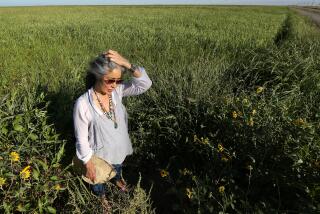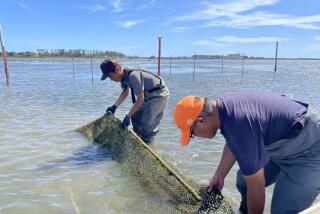Japanese Silkworm Farmers’ Survival Is Threatened : Agriculture: Cheaper goods have hurt them. Pressure is building to end their government subsidy.
- Share via
TOKYO — A century ago, the humble silkworm led Japan on its march to becoming an economic superpower.
Silk farmers have been protected by import restrictions and soaring subsidies ever since. Now they’re wondering how much longer they can survive.
Their numbers are declining in the face of a flood of finished goods from China and South Korea, and the current Uruguay Round of GATT trade talks is firmly opposed to continued protection of Japanese farm goods.
A recent study by the Ministry of Agriculture, Forestries and Fisheries found that the number of cocoon growers has dropped from 248,000 to 44,000 in the 16 years up to 1991.
Japan’s raw silk production fell from 236,000 (132-pound) bales in 1981 to 90,000 bales in 1991. Cocoon output fell from 65,000 metric tons to 21,000 metric tons over the same period.
But ministry officials remain defiant.
“Perhaps we cannot stop the drop in silk farmers, but our job is to protect the regional economies and the people who can grow only cocoons,” one official said.
“As long as the kimono exists as our national dress, we can expect strong demand for Japanese silk, and people will realize the quality of Japanese silk,” he said. “Beef is a very good example. Good-quality products will win out in the end.”
Since the beef market was opened last year, Japanese beef has retained a strong market share as high-quality meat, while American or Australian beef is chosen for the everyday menu.
Japanese silk is longer and stronger than foreign silk, making it suitable for the kimono, the traditional long gown now used mainly for wedding and ceremonial occasions.
But economics seem to contradict the ministry’s view.
On July 29, the Yokohama futures market saw the price of August silk contracts skid to 10,400 Japanese yen ($81) per kilogram, the lowest price since December, 1987. The new low came despite the fact that domestic demand for silk since 1987 steadily increased to 310,700 bales in 1991--30% of the world market.
Iwao Iwamoto, an industry analyst at Commodity Market Research Institute Co., said the time has come for the government to abandon its import monopoly.
In January, 1952, Japan introduced its Silk Price Stabilizing System, under which the ministry decides on a price high and low every year as a standard on which to base market intervention.
Since 1974, the semi-government Silk Agency has been the only organization that can legally import raw silk and dried cocoon.
From 1952 to 1987, Japan spent millions of yen a year out of the budget to keep domestic prices high, matching the level of local growers. The precise figure has not been published.
In 1987, the Silk Agency ran a cumulative deficit of 120 billion yen ($937 million) from its market operations.
Since 1987 and the rise of the yen, the lucrative Japanese market has been flooded with foreign silk-processed goods such as thread, textiles and secondary products, mainly from China and South Korea. The import system has been ineffective in controlling prices.
“Japanese weavers have to pay twice as much as international prices for raw silk, so it is impossible for them to compete in the market,” said Iwamoto. “They really suffer, since they receive neither protection nor subsidies.”
Not surprisingly, cocoon farmers and raw silk producers are bitterly opposed to liberalization of the market.
“As soon as we open our silk market, prices will drop to the international price of 7,800 yen ($60) per kilogram,” said an official of the Japan Silk Manufacturers Assn.
The current price for domestic silk is around 10,700 yen ($83) per kilogram.
But pressure for liberalization is building from the international community.
More to Read
Sign up for Essential California
The most important California stories and recommendations in your inbox every morning.
You may occasionally receive promotional content from the Los Angeles Times.













